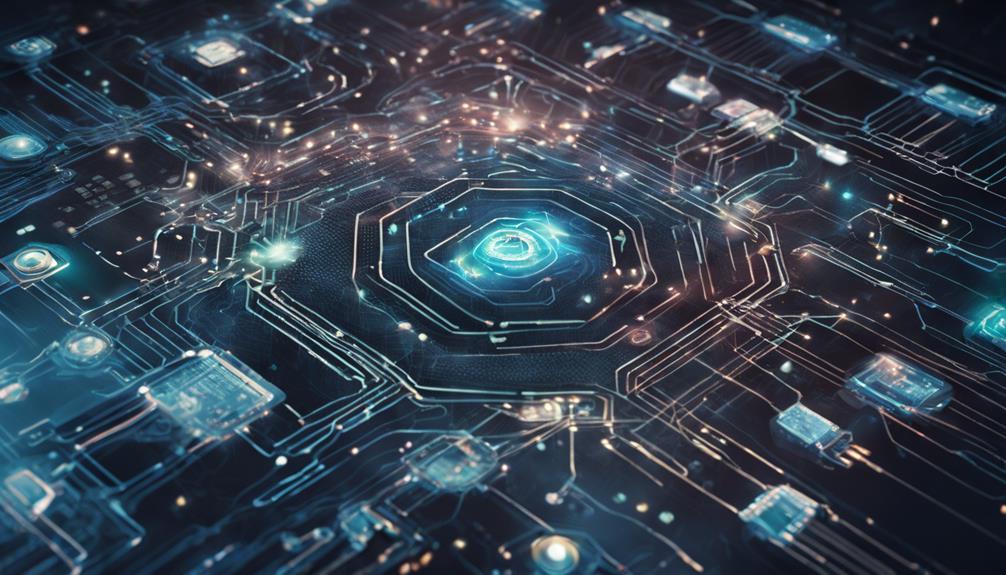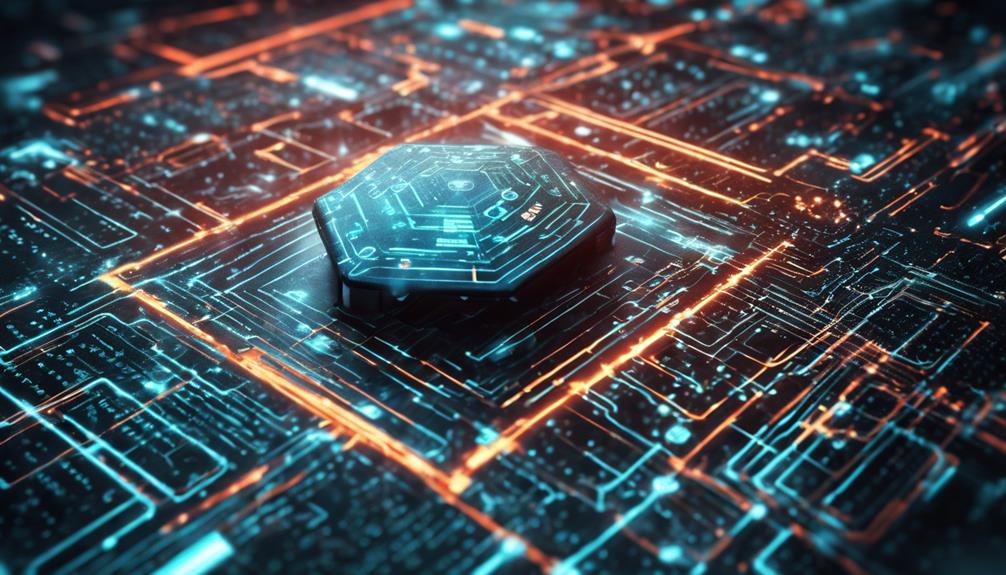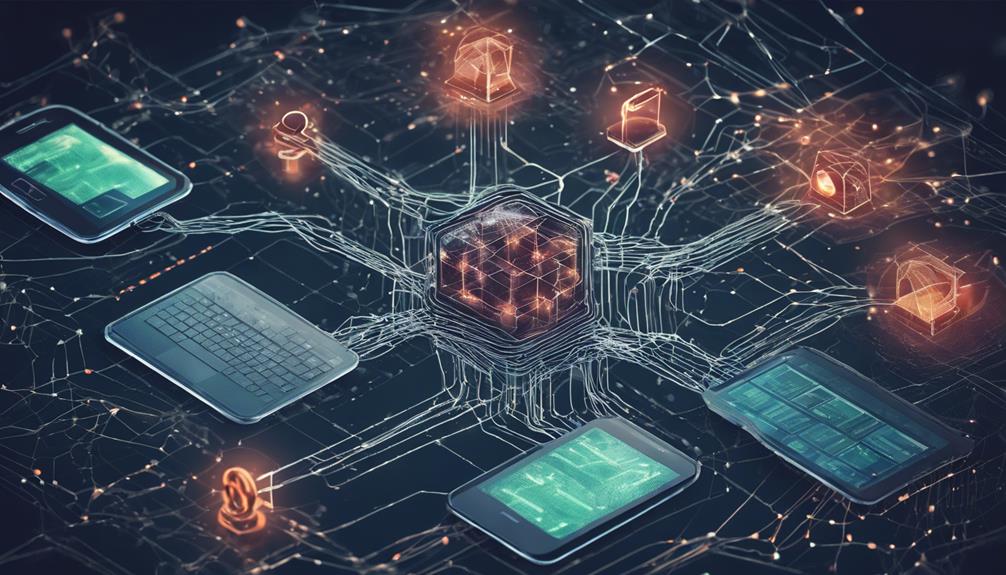Innovative AI cybersecurity projects for 2023 focus on cutting-edge threat detection using advanced machine learning algorithms. Real-time monitoring solutions swiftly analyze data for proactive defense mechanisms and reducing false positives. Adaptive response mechanisms dynamically adjust security measures for immediate threat mitigation, essential for robust defense. Continuous system monitoring actively tracks network activities, empowering proactive security enhancement. Autonomous response capabilities enable automatic threat mitigation, reducing cyber attack impact. Advanced machine learning algorithms enhance threat detection efficiency, reducing false positives by up to 70%. These solutions represent the future of cybersecurity defense, embracing AI technology to stay ahead of evolving threats.
Key Takeaways
- AI-driven projects integrate advanced machine learning for real-time threat detection.
- Collaboration with academic institutions enhances innovative cybersecurity solutions.
- Automated response systems reduce cyber attack impact with swift mitigation.
- Continuous learning AI systems proactively identify and address evolving threats.
- Behavioral analytics and anomaly detection bolster AI-driven threat detection technologies.
Cutting-Edge AI Threat Detection
In the field of cybersecurity advancements, cutting-edge AI threat detection projects are at the forefront of innovation, utilizing machine learning algorithms to analyze vast amounts of data for real-time threat identification. These AI solutions represent a significant leap forward in the fight against cyber threats, offering proactive detection and mitigation capabilities.
By continuously learning and adapting to evolving threats, these AI-driven systems provide accurate and efficient threat detection, bolstering overall cybersecurity defenses.
The integration of machine learning in cybersecurity projects enables the development of sophisticated algorithms that can quickly identify and respond to potential threats before they escalate. These innovative AI solutions not only streamline threat detection processes but also enhance the overall security posture of organizations by staying ahead of cyber adversaries.
With advanced AI algorithms powering these initiatives, cybersecurity professionals can leverage technology to stay one step ahead in the ever-evolving landscape of cyber threats.
Real-Time Monitoring Solutions

Real-time monitoring solutions are crucial in AI cybersecurity projects. They provide continuous threat detection and response capabilities. These solutions use machine learning algorithms to analyze incoming data quickly, identifying potential security risks in real-time.
Threat Detection Accuracy
Enhancing threat detection accuracy through real-time monitoring solutions is a primary focus of AI cybersecurity projects in 2023. By utilizing advanced machine learning algorithms, these projects can swiftly analyze vast data sets to identify potential threats in real-time.
Real-time monitoring solutions play an essential role in providing proactive defense mechanisms by enabling immediate detection and response to cyber threats within seconds of detection.
One of the key objectives of AI-driven cybersecurity projects is to reduce false positives and enhance the overall efficiency of threat detection processes. Through the integration of AI technologies, these projects aim to achieve higher accuracy rates in both identifying and mitigating potential threats.
Adaptive Response Mechanisms
AI cybersecurity projects leverage adaptive response mechanisms, utilizing real-time monitoring solutions to dynamically adjust security measures based on evolving threats. These innovative solutions enable immediate threat detection and response, ensuring that organizations can stay a step ahead of cyber attackers.
By incorporating AI into real-time monitoring, cybersecurity systems can proactively identify and mitigate risks before they escalate into full-blown breaches. This approach not only enhances the overall security posture but also minimizes the potential impact of cyber incidents on critical data and systems.
The use of adaptive response mechanisms in cybersecurity projects is essential for maintaining a robust defense against constantly evolving threats in today's digital landscape. By continuously monitoring for anomalies and suspicious activities in real-time, organizations can swiftly adapt their security protocols to address emerging risks effectively.
Investing in AI-driven real-time monitoring solutions is vital for organizations looking to bolster their cybersecurity posture and protect their valuable assets from malicious actors.
Continuous System Monitoring
Continuous system monitoring in cybersecurity projects involves the active tracking and analysis of network activities using real-time solutions. These cutting-edge cybersecurity solutions leverage AI algorithms to swiftly detect anomalies, unauthorized access attempts, and potential security threats in real-time. By offering continuous oversight, these monitoring tools enable organizations to promptly respond to cyber incidents, thereby fortifying their defenses against data breaches.
Real-time monitoring solutions provide valuable insights into network behavior, user activities, and system vulnerabilities, empowering organizations to proactively address security gaps.
AI-powered continuous monitoring tools play an essential role in enhancing cybersecurity measures by identifying risks, mitigating threats effectively, and ensuring the protection of sensitive data 24/7. Through the constant vigilance enabled by these advanced solutions, organizations can stay ahead of evolving cyber threats and safeguard their digital assets with confidence.
Autonomous Response Capabilities

Autonomous response capabilities play a crucial role in AI cybersecurity projects by enabling real-time threat detection and automatic mitigation of cyber attacks. Leveraging advanced AI algorithms, these solutions analyze security incidents swiftly, allowing for immediate responses without the need for human intervention.
By integrating autonomous response features, AI cybersecurity projects can actively shield against the ever-evolving landscape of cyber threats. The proactive nature of autonomous response capabilities assists organizations in reducing the impact of cyber attacks, thereby minimizing potential damage to their systems and data.
In 2023, the adoption of autonomous response in AI cybersecurity projects signifies a paradigm shift towards more efficient and effective cybersecurity practices. Embracing autonomous response capabilities not only enhances response times but also strengthens the overall resilience of cybersecurity defenses, ensuring a robust shield against malicious cyber activities.
Organizations stand to benefit greatly from these innovative solutions in safeguarding their digital assets and maintaining operational continuity in the face of cyber threats.
Advanced Machine Learning Algorithms
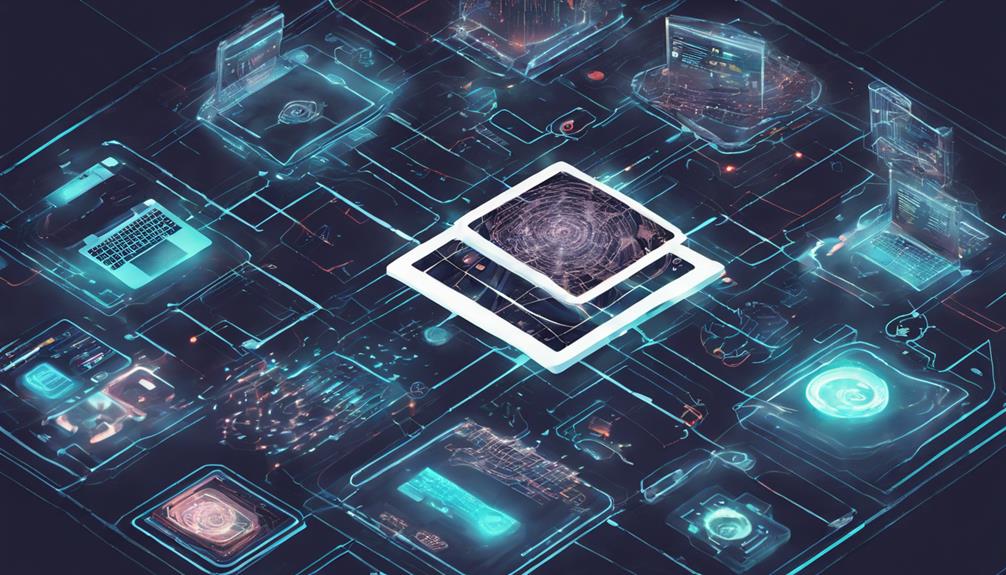
Sophisticated machine learning algorithms employed in cybersecurity projects greatly enhance the accuracy and efficiency of threat detection processes. By leveraging these advanced algorithms, organizations can achieve up to a remarkable 99% improvement in identifying cyber threats promptly. These machine learning algorithms analyze vast amounts of data in real-time, allowing for swift responses to potential security breaches. Additionally, the adaptive nature of AI-driven machine learning models enables them to stay ahead of evolving threats, thereby bolstering the overall security posture of organizations.
In addition to enhancing threat detection capabilities, machine learning algorithms in cybersecurity projects play an essential role in reducing false positives by an impressive 70%. This significant reduction not only minimizes alert fatigue for security teams but also streamlines the identification of genuine threats.
Moreover, the utilization of advanced algorithms facilitates proactive threat hunting and the implementation of effective mitigation strategies, ensuring a proactive approach to cybersecurity.
Industry-Leading Cybersecurity Innovations

UC Santa Barbara spearheads the $20 million AI cybersecurity project, ACTION, focusing on AI continuous learning to combat security threats effectively.
Collaborating with esteemed institutions like UC Berkeley and Purdue University, the project aims to blend AI with human expertise for robust security measures.
Cutting-edge Security Technologies
Cutting-edge security technologies in the cybersecurity industry are revolutionizing threat detection and response capabilities through the integration of AI-powered platforms like SentinelOne and Vectra AI. These innovative solutions leverage AI security and deep learning to stay ahead of evolving cyber threats, enhancing threat intelligence and response times.
In addition to these industry leaders, companies like Darktrace are integrating autonomous response technology and real-time threat detection to combat cyber threats effectively. Drata offers a cloud-based platform tailored for security and compliance automation, adapting to various industry-specific needs.
Trail of Bits specializes in providing cutting-edge cybersecurity expertise for sensitive sectors such as defense, finance, and technology. Finally, Sift stands out in fraud prevention using AI and machine learning, offering advanced security solutions for e-commerce and financial services.
Embracing these cybersecurity trends can greatly bolster an organization's defenses against modern cyber threats.
Advanced Threat Detection
In the field of cybersecurity innovation, industry-leading advancements in advanced threat detection are reshaping the landscape of defense against evolving cyber threats. UC Santa Barbara's AI cybersecurity project, ACTION, funded by a substantial grant from the National Science Foundation, is at the forefront of revolutionizing threat detection.
This project integrates AI continuous learning and reasoning to enhance security measures against sophisticated attacks. By combining foundational AI principles with cybersecurity expertise, the research team aims to develop intelligent agents capable of swiftly identifying and mitigating threats.
The collaboration with esteemed institutions like UC Berkeley and Purdue University underscores the project's commitment to merging human intelligence with AI capabilities for more robust security solutions. The innovative approach of building joint human-AI systems sets a precedent for future cybersecurity endeavors, ensuring a proactive stance against threats by addressing scale and time requirements effectively.
The ACTION institute's pioneering work promises to elevate AI cybersecurity research to new heights, offering promising prospects for enhanced threat detection strategies.
Enhanced Threat Detection Technologies
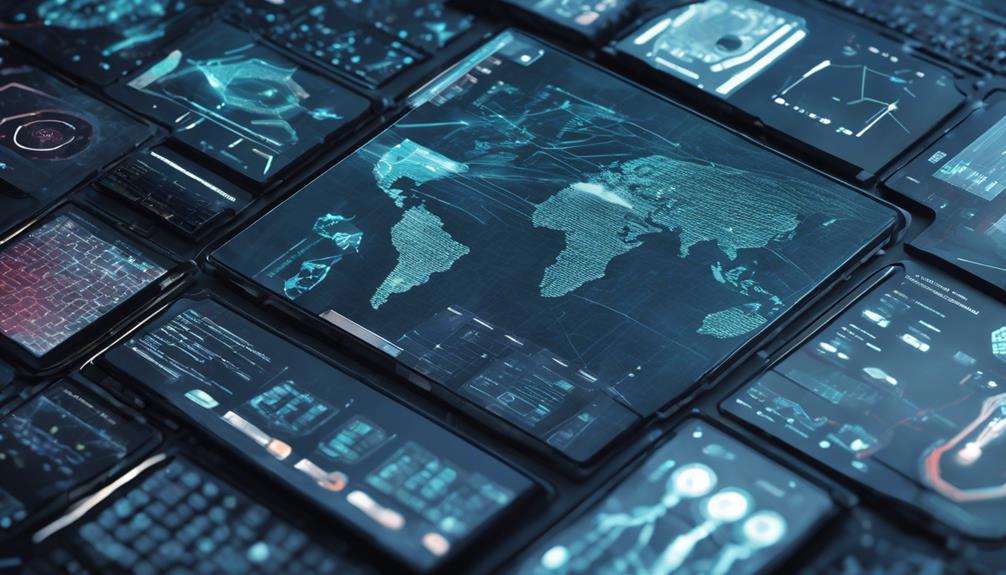
The implementation of AI in cybersecurity projects is revolutionizing threat detection technologies through advanced machine learning algorithms. This integration enables systems to analyze vast amounts of data swiftly, identifying potential cyber threats in real-time.
Enhanced threat detection technologies in 2023 leverage AI-driven approaches, emphasizing behavioral analytics and anomaly detection to proactively safeguard against evolving cybersecurity threats. To enhance threat detection capabilities further, cybersecurity projects are focusing on:
- Real-time Analysis: Utilizing AI for continuous monitoring and analysis of network activities to detect abnormalities promptly.
- Behavioral Analytics: Applying machine learning algorithms to understand typical user behavior patterns and recognize deviations that may indicate a potential threat.
- Proactive Response: Enhancing response mechanisms by leveraging AI insights to swiftly address identified threats before they escalate.
Automated Cyber Threat Response

AI-driven automated cyber threat response systems revolutionize how organizations detect and respond to security incidents in real-time, enhancing overall cybersecurity resilience. These systems harness the power of machine learning algorithms to swiftly identify and address potential threats without the need for manual intervention. By automating threat response processes, organizations can minimize response times and effectively thwart cyber attacks, reducing the risk of substantial damages.
Additionally, these AI-driven solutions continuously learn and adapt to new cybersecurity threats, providing organizations with the ability to stay ahead of malicious actors.
Taking a proactive approach, AI in cybersecurity enables automated threat response systems to offer improved visibility into security incidents, allowing for the prompt prioritization and resolution of critical threats. This proactive stance not only strengthens cybersecurity defenses but also empowers organizations to proactively safeguard their digital assets.
Embracing automated cyber threat response is an essential step towards fortifying cybersecurity postures in the face of increasingly sophisticated cyber threats.
AI Solutions for Digital Asset Protection

Utilizing cutting-edge technology, cybersecurity projects focus on deploying AI solutions to safeguard digital assets against emerging cyber threats. Here are three key ways AI is transforming digital asset protection:
- Enhanced Threat Detection: AI-driven cybersecurity projects leverage machine learning algorithms to detect and analyze potential threats in real-time. By continuously learning from patterns and anomalies, AI solutions can identify and respond to new cyber threats swiftly, bolstering overall security measures.
- Improved Response Capabilities: Incorporating AI technologies enables organizations to enhance their response capabilities to cyber incidents. Through automated responses and intelligent decision-making processes, AI solutions can mitigate risks and minimize the impact of cybersecurity breaches on digital assets.
- Real-time Monitoring and Analysis: AI solutions provide organizations with the ability to monitor their digital assets in real-time, analyze security data efficiently, and proactively address vulnerabilities. This proactive approach helps in strengthening the security posture of organizations and safeguarding valuable digital assets effectively.
Frequently Asked Questions
What Is the Future of Cybersecurity in 2023?
The future of cybersecurity in 2023 will revolve around AI-driven threat detection, cloud security advancements, zero-trust models for continuous authentication, increased IoT security investments, and heightened focus on protecting 5G networks. Organizations must adapt to evolving cyber threats with innovative solutions.
What Is the Future Use of AI in Cyber Security?
The future use of AI in cybersecurity involves continued integration of machine learning and deep learning algorithms to enhance threat detection capabilities, improve incident response times, reduce false positives, and enable real-time proactive identification of security risks.
What Is the Main AI Use Case in Cybersecurity?
Enhancing threat detection and response capabilities, AI's main use case in cybersecurity involves continuous monitoring and analysis of network activities. By identifying patterns of malicious behavior and automating processes, AI improves security posture, enabling proactive threat mitigation.
Will AI Replace Cyber Security Professionals?
AI will not replace cybersecurity professionals but enhance their capabilities. Human judgment is vital for decision-making and strategy. Collaborative efforts between AI and professionals are essential for maximizing cybersecurity effectiveness in the evolving digital landscape.
Conclusion
Innovative AI cybersecurity projects offer cutting-edge solutions for 2023, incorporating advanced machine learning algorithms, real-time monitoring, and autonomous response capabilities.
These industry-leading innovations provide enhanced threat detection technologies and automated cyber threat response, ensuring digital asset protection.
With these groundbreaking advancements, organizations can stay ahead of evolving cyber threats and safeguard their sensitive information effectively.
Embrace the future of cybersecurity with AI solutions that offer unparalleled protection against malicious attacks.
